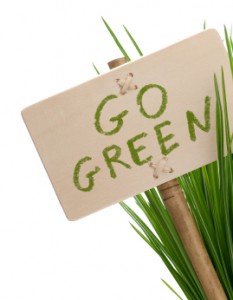Everyday it seems we hear about new natural catastrophes caused by humanity’s pollutive and careless ways: another glacier in the arctic melts off, another school of dead fish floats up in the harbor, or another abnormally warm winter.
As a result, we are starting to become more environmentally conscious both as individuals as well as business organizations. Thus the eco-friendly event is born, and becoming widely popular not only for its obvious reason of helping the environment, but also for the fact that people hold a certain respect for a company that goes green, which for the company’s sake will hopefully translate into even more green in the form of profits.
In fact, environmentally friendly events have become so popular, there are even event planning businesses that only specialize in them. Companies like GRN Events and 2121 Events concentrate on providing solely eco-friendly event planning services by using biodegradable materials and recycled fabrics. Get ready to ditch the water bottles and pick up a compostable cup as we delve into the most common ways to make your event appease mother nature.
At many events, it is the most mundane and ordinary things that people never think about that can add up to the most garbage. Even simple things like cups, plates, and cutlery can amount to a ton of trash. Thankfully there are several new companies popping up that offer biodegradable options. Companies like Eco-Products, BioSmart, and Susty Party sell a smorgasbord of biodegradable flatware, cups, cutlery, containers, bags, and other packing materials. And what’s even better is that most of these companies will come pick up this trash when your event is over and compost it for you! Furthermore, research has shown that something as simple as biodegradable cups and water filling stations can save up to the tens of thousands of dollars in bottled water costs, depending on the size of the event.
In the same spirit as the eating materials, reducing paper in all aspects of an event should be pursued. Things like using cardboard and recycled paper for signage and name tags can help cut back on a lot of killed trees. Event planners should encourage sponsors and contributors to fill swag bags with biodegradable items and goodies, rather than hard items such as coupons, brochures, and plastic pens, most of which will end up in the garbage anyways. Many event planners have gone electronic by providing event maps and brochures digitally, accessible by almost any modern day cellular device. Other alternatives include flash drives containing event guides, or fixed iPad stations where attendees can browse event details.
In regards to food and drink, of course the more sustainable the better. However, often the most sustainable wines, produce, and meats may not be the closest to the location of your event, and the added fossil-fuel usage, smog emissions, and packing materials from shipping and handling can actually increase your carbon footprint instead of lowering it. At the very least, it’s best to stick with locally grown products and edibles to cut down on shipping.
Other tips include having clearly marked recyclable and waste bins, so that people can easily separate their disposables, choosing eco-conscious contractors who use un-harmful materials for setting up stages and set designs, and even renting green porta potties which are free of toxic chemicals like formaldehyde and alcohol. Every little change can help make a big impact without taking away from your event.


